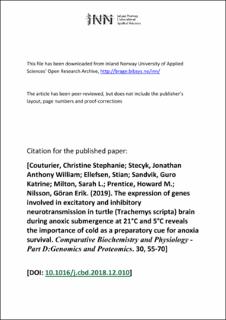| dc.contributor.author | Couturier, Christine Stephanie | |
| dc.contributor.author | Stecyk, Jonathan Anthony William | |
| dc.contributor.author | Ellefsen, Stian | |
| dc.contributor.author | Sandvik, Guro Katrine | |
| dc.contributor.author | Milton, Sarah L. | |
| dc.contributor.author | Prentice, Howard M. | |
| dc.contributor.author | Nilsson, Göran Erik | |
| dc.date.accessioned | 2020-11-02T08:07:04Z | |
| dc.date.available | 2020-11-02T08:07:04Z | |
| dc.date.created | 2019-06-11T09:48:36Z | |
| dc.date.issued | 2019 | |
| dc.identifier.citation | Comparative Biochemistry and Physiology - Part D:Genomics and Proteomics. 2019, 30 55-70. | en_US |
| dc.identifier.issn | 1744-117X | |
| dc.identifier.uri | https://hdl.handle.net/11250/2685975 | |
| dc.description.abstract | We investigated if transcriptional responses are consistent with the arrest of synaptic activity in the anoxic turtle (Trachemys scripta) brain. Thirty-nine genes of key receptors, transporters, enzymes and regulatory proteins of inhibitory and excitatory neurotransmission were partially cloned and their expression in telencephalon of 21 °Cand 5 °C-acclimated normoxic, anoxic (24 h at 21 °C; 1 and 14 days at 5 °C) and reoxygenated (24 h at 21 °C; 13 days at 5 °C) turtles quantified by real-time RT-PCR. Gene expression was largely sustained with anoxia at 21 °C and 5 °C. However, the changes in gene expression that did occur were congruous with the decline in glutamatergic activity and the increase in GABAergic activity observed at cellular and whole organism levels. Moreover, at 21 °C, the alterations in gene expression with anoxia induced a distinct gene expression pattern compared to normoxia and reoxygenation. Strikingly, acclimation from 21 °C to 5 °C in normoxia effectuated substantial transcriptional responses. Most prominently, 56% of the excitatory neurotransmission genes were down-regulated, including most of the ones encoding the subunits composing excitatory N-methyl-D-aspartate (NMDA) and 3-hydroxy-5-methyl-4-isoxazole propionate (AMPA) glutamate receptors. By contrast, only 26% of the inhibitory neurotransmission genes were down-regulated. Consequently, the gene expression pattern of 5 °C normoxic turtles was statistically distinct compared to that of 21 °C normoxic turtles. Overall, this study highlights that key transcriptional responses are consonant with the synaptic arrest that occurs in the anoxic turtle brain. In addition, the findings reveal that transcriptional remodelling induced by decreased temperature may serve to precondition the turtle brain for winter anoxia. | en_US |
| dc.language.iso | eng | en_US |
| dc.rights | Attribution-NonCommercial-NoDerivatives 4.0 Internasjonal | * |
| dc.rights.uri | http://creativecommons.org/licenses/by-nc-nd/4.0/deed.no | * |
| dc.subject | GABA | en_US |
| dc.subject | gene expression | en_US |
| dc.subject | glutamate | en_US |
| dc.subject | mRNA | en_US |
| dc.subject | reoxygenation | en_US |
| dc.subject | synaptic arrest | en_US |
| dc.subject | telencephalon | en_US |
| dc.subject | temperature | en_US |
| dc.title | The expression of genes involved in excitatory and inhibitory neurotransmission in turtle (Trachemys scripta) brain during anoxic submergence at 21°C and 5°C reveals the importance of cold as a preparatory cue for anoxia survival | en_US |
| dc.type | Peer reviewed | en_US |
| dc.type | Journal article | en_US |
| dc.description.version | publishedVersion | en_US |
| dc.source.pagenumber | 55-70 | en_US |
| dc.source.volume | 30 | en_US |
| dc.source.journal | Comparative Biochemistry and Physiology - Part D:Genomics and Proteomics | en_US |
| dc.identifier.doi | 10.1016/j.cbd.2018.12.010 | |
| dc.identifier.cristin | 1703843 | |
| cristin.unitcode | 209,4,4,0 | |
| cristin.unitname | Idrettshøgskolen Innlandet | |
| cristin.ispublished | true | |
| cristin.fulltext | original | |
| cristin.qualitycode | 1 | |

